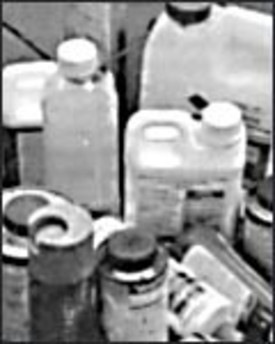Avoid household products with hazardous ingredients, or handle them with extreme care. Many toxic ingredients in paint thinners and drain cleaners, for example, can contaminate water sources.
- Use only enough of the product to get the job done.
- Never dump hazardous products down drains, the toilet, or near flowing water, ponds, or lakes.
- Do not dump them on the ground.
- Use natural and less-toxic household products whenever possible. See the table below.
| Instead of: | Use: | |
| Air freshener | A small dish of vinegar or lemon juice set out in a warm area. | |
| All-purpose cleaner | One quart warm water, 1 teaspoon liquid soap, 1 teaspoon borax, and 1/4 cup vinegar. | |
| Bleach | Borax | |
| Carpet cleaner | To neutralize odors, sprinkle the carpet with a mixture of one cup borax and 2 cups cornmeal or use baking soda. Let stand 1 hour before vacuuming. | |
| Chlorine scouring powder | Baking soda | |
| Detergent | Simple soap or phosphate-free detergent | |
| Disinfectant | Ammonia | |
| Drain cleaner | Plunger, followed by a handful of baking soda and a half cup of vinegar. Cover and allow to sit for 15 minutes. Pour in 2 quarts of boiling water, and the clod should disappear. | |
| Floor cleaner | Mop floors with a mild soap solution or 1 cup vinegar mixed with 2 gallons of water. Linoleum floors can be polished by mopping with skim milk. (No, it doesn’t smell.) | |
| Furniture polish | On unfinished surfaces, use natural oil such as almond or olive oil. On finished surfaces, dust with a damp cloth and wipe dry. | |
| Glass cleaner | Two tablespoons of vinegar to 1 quart of water. | |
| Grease remover | Baking soda paste | |
| Mildew stain remover | Vinegar solution | |
| Mothballs | Cedar chips | |
| Oven cleaner | Pour salt on fresh oven spills, and scrape the residue off when the oven cools. Ammonia can be applied t tough stains. A pumice stick, available at many hardware stores, will also work. | |
| Pest control | Make chili powder packets to keep ants out of your kitchen. | |
| Stain remover | Cornstarch paste | |
| Surface cleaner | Use a vinegar and salt mixture. | |
| Tile cleaner | Scrub areas with baking soda and a toothbrush. | |
| Toilet bowl cleaner | Baking soda or borax | |
| Window cleaner | Mix 1/4 cup of white vinegar or 2 tablespoons of lemon juice and a quart of warm water. |
Common Stains Often Treatable with Nontoxic Materials
Alcoholic beverages (including wine) – Blot spilled drinks promptly and sponge with cool water. This should remove most of the color, even if it has already dried. Rubbing alcohol or white wine may also work in a pinch, but they may affect fabric color. If clothing is washable, follow instructions for non-greasy stains.
Blood – First, soak or rub in cold water until stain is almost gone. Then, if fabric is washable, launder in warm water and detergent. On non-washable materials try a little borax or hydrogen peroxide to get the last traces out. Once blood stains set, they are difficult to remove, but a warm solution of trisodium phosphate will sometimes work on cotton or linen.
Coffee, tea – These are easier to remove if no cream was involved. Treat as non-greasy stain with cold water. If cream was involved, follow directions for combination stains, treating first with water, then detergent. A solvent may be necessary.
Egg – Never use hot water on an egg stain because it will set the stain. Scrape off as much as possible with a dull knife, then sponge or soak with cold water. Launder if possible.




























